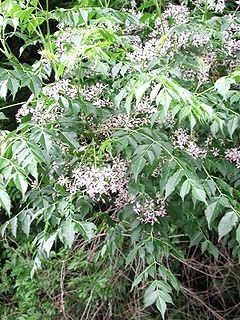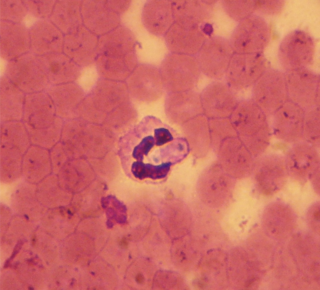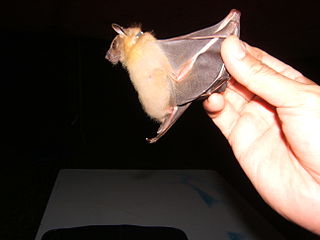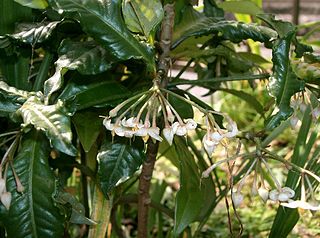
Meliaceae, the mahogany family, is a flowering plant family of mostly trees and shrubs in the order Sapindales.

Ticks are parasitic arachnids that are part of the superorder Parasitiformes. Along with mites, they constitute the subclass Acari. Adult ticks are approximately 3 to 5 mm in length depending on age, sex, species, and "fullness". Ticks are external parasites, living by feeding on the blood of mammals, birds, and sometimes reptiles and amphibians. It is estimated ticks originated during the Late Cretaceous period, approximately 120 MYA, the earliest tick fossil in New Jersey amber is dated at 90-94 million years old. Ticks are widely distributed around the world, especially in warm, humid climates.

A raceme or racemoid is an unbranched, indeterminate type of inflorescence bearing pedicellate flowers along its axis. In botany, an axis means a shoot, in this case one bearing the flowers. In indeterminate inflorescence-like racemes, the oldest flowers are borne towards the base and new flowers are produced as the shoot grows, with no predetermined growth limit. A plant that flowers on a showy raceme may have this reflected in its scientific name, e.g. Cimicifuga racemosa. A compound raceme, also called a panicle, has a branching main axis. Examples of racemes occur on mustard and radish plants.

Tsuga is a genus of conifers in the subfamily Abietoideae. The common name hemlock is derived from a perceived similarity in the smell of its crushed foliage to that of the unrelated plant poison hemlock. Unlike the latter, Tsuga species are not poisonous.

Scabiosa is a genus in the honeysuckle family (Caprifoliaceae) of flowering plants. Many of the species in this genus have common names that include the word scabious, but some plants commonly known as scabious are currently classified in related genera such as Knautia and Succisa; at least some of these were formerly placed in Scabiosa. Another common name for members of this genus is pincushion flowers.

Hepatozoon is a genus of Apicomplexa alveolates which incorporates over 300 species obligate intraerythrocytic parasites. Species have been described from all groups of tetrapod vertebrates, as well as a wide range of haematophagous arthropods, which serve as both the vectors and definitive hosts of the parasite. By far the most biodiverse and prevalent of all haemogregarines, the genus is distinguished by its unique reciprocal trophic lifecycle which lacks the salivary transmission between hosts commonly associated with other apicomplexans. While particularly prevalent in amphibians and reptiles, the genus is more well known in veterinary circles for causing a tick-borne disease called hepatozoonosis in some mammals.

Athrotaxis is a genus of two to three species of conifers in the cypress family, Cupressaceae. The genus is endemic to western Tasmania, where they grow in high altitude temperate rainforests.

Cynopterus is a genus of megabats. The cynopterine section is represented by 11 genera, five of which occur in Malaysia, namely, Chironx, Balionycteris, Penthetor, Dyacopterus, and Cynopterus. About 30 names for Cynopterus species have been proposed, but only 16 are taxonomically valid forms.
Furovirus is a genus of viruses, in the family Virgaviridae. Graminae, winter wheat, wheat, triticale, oat, sorghum bicolor, and plants serve as natural hosts. There are currently six species in this genus including the type species Soil-borne wheat mosaic virus. Diseases associated with this genus include: (SBWMV): green and yellow mosaic.

Pandanaceae is a family of flowering plants native to the tropics and subtropics of the Old World, from West Africa through the Pacific. It contains 982 known species in five genera, of which the type genus, Pandanus, is the most important, with species like Pandanus amaryllifolius and karuka being important sources of food. It is an ancient family dating from the early to mid-Cretaceous.

Ardisia is a genus of flowering plants in the family Primulaceae. It was in the former Myrsinaceae family now recognised as the myrsine sub-family Myrsinoideae. They are distributed in the Americas, Asia, Australia, and the Pacific Islands, mainly in the tropics. There are over 700 accepted species. One species, Ardisia japonica is one of the 50 fundamental herbs in traditional Chinese medicine.

Iltovirus is a genus of viruses in the order Herpesvirales, in the family Herpesviridae, in the subfamily Alphaherpesvirinae. Birds, galliform birds, psittacine birds, chickens, turkeys, and quail serve as natural hosts. There are currently only two species in this genus including the type species Gallid alphaherpesvirus 1. Diseases associated with this genus include: acute respiratory diseases: gaHV-1: infectious laryngotracheitis; psHV-1: Pacheco's disease.

Benyvirus is a genus of viruses, in the family Benyviridae. Plant serve as natural hosts. There are currently four species in this genus including the type species Beet necrotic yellow vein virus. Diseases associated with this genus include: BNYVV: rhizomania.

The Haemosporida are an order of intraerythrocytic parasitic alveolates.
Rickettsia felis is a species of bacterium, the pathogen that causes cat-flea typhus in humans. In cats the disease is known as flea-borne spotted fever. Rickettsia felis also is regarded as the causative organism of many cases of illnesses generally classed as fevers of unknown origin in humans in Africa.

Persoonia juniperina, commonly known as prickly geebung, is a species of flowering plant in the family Proteaceae and is endemic to south-eastern Australia. It is a small erect to low-lying shrub with smooth bark, hairy new branches, linear leaves, yellow flowers borne singly or in groups of up to forty in leaf axils, and yellowish green to purplish fruit.

Taeniocrada is a genus of extinct plants of Devonian age. It is used as a form genus for fossil plants with leafless flattened stems which divided dichotomously and had prominent midribs regarded as containing vascular tissues. It has been suggested that some species assigned to this genus were aquatic.
Mengla dianlovirus is a type of filovirus identified in a Rousettus bat in Mengla County, Yunnan Province, China and first reported in January 2019. It is classified in the same family as Ebolavirus and Marburgvirus.

Protea repens, known as the common sugarbush and in Afrikaans as the suikerbossie, is an erect shrub growing in the southern regions of South Africa. Related to other proteas, this plant is a relatively adaptable and variable species and can be found growing widely in various soils. Due to its showy flowers and adaptability, it is a popular garden subject for use in wildlife gardens in South Africa.















